Top Rankings
Medford SD 549c School District ranks among the top 20% of public school district in Oregon for:
Category
Attribute
Graduation Rate
Highest graduation rate (Top 20%)
Community Size
Largest student body (number of students) (Top 1%)
For the 2025 school year, there is 1 public preschool serving 469 students in Medford SD 549c School District. This district's average pre testing ranking is 2/10, which is in the bottom 50% of public pre schools in Oregon.
Public Preschool in Medford SD 549c School District have an average math proficiency score of 11% (versus the Oregon public pre school average of 33%), and reading proficiency score of 30% (versus the 42% statewide average).
Minority enrollment is 78% of the student body (majority Hispanic), which is more than the Oregon public preschool average of 52% (majority Hispanic).
Overview
This School District
This State (OR)
# Schools
25 Schools
91 Schools
# Students
13,712 Students
29,714 Students
# Teachers
701 Teachers
1,885 Teachers
Student : Teacher Ratio
20:1
20:1
District Rank
Medford SD 549c School District, which is ranked within the top 50% of all 186 school districts in Oregon (based off of combined math and reading proficiency testing data) for the 2021-2022 school year.
The school district's graduation rate of 87% has increased from 78% over five school years.
Overall District Rank
#73 out of 189 school districts
(Top 50%)
(Top 50%)
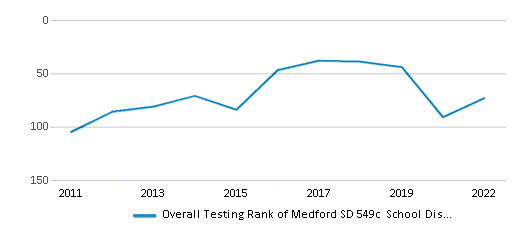
Math Test Scores (% Proficient)
29%
31%
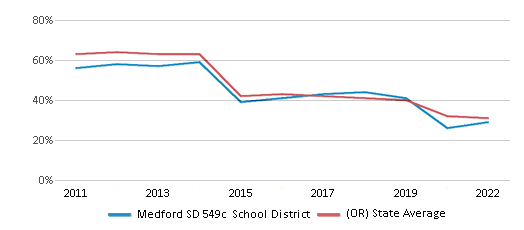
Reading/Language Arts Test Scores (% Proficient)
44%
44%

Science Test Scores (% Proficient)
33%
30%
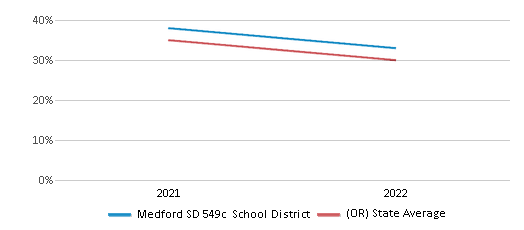
Graduation Rate
87%
81%
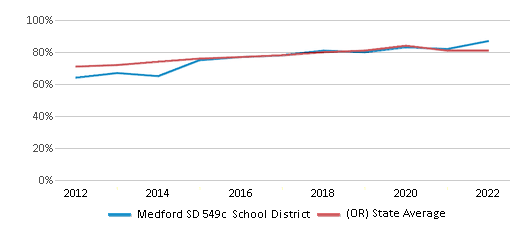
Students by Ethnicity:
Diversity Score
0.53
0.67
# American Indian Students
82 Students
200 Students
% American Indian Students
1%
1%
# Asian Students
173 Students
1,549 Students
% Asian Students
1%
5%
# Hispanic Students
3,846 Students
8,817 Students
% Hispanic Students
28%
30%
# Black Students
133 Students
1,664 Students
% Black Students
1%
6%
# White Students
8,629 Students
14,394 Students
% White Students
63%
48%
# Hawaiian Students
85 Students
371 Students
% Hawaiian Students
1%
1%
# Two or more races Students
734 Students
2,665 Students
% of Two or more races Students
5%
9%
Students by Grade:
# Students in PK Grade:
-
-
# Students in K Grade:
957
4,906
# Students in 1st Grade:
983
4,696
# Students in 2nd Grade:
1,121
4,983
# Students in 3rd Grade:
1,018
4,490
# Students in 4th Grade:
1,111
4,747
# Students in 5th Grade:
1,090
4,341
# Students in 6th Grade:
1,081
599
# Students in 7th Grade:
1,064
330
# Students in 8th Grade:
1,084
296
# Students in 9th Grade:
1,098
77
# Students in 10th Grade:
1,076
82
# Students in 11th Grade:
1,069
91
# Students in 12th Grade:
960
76
# Ungraded Students:
-
-
District Revenue and Spending
The revenue/student of $14,541 in this school district is less than the state median of $18,279. The school district revenue/student has stayed relatively flat over four school years.
The school district's spending/student of $13,321 is less than the state median of $19,325. The school district spending/student has stayed relatively flat over four school years.
Total Revenue
$199 MM
$9,902 MM
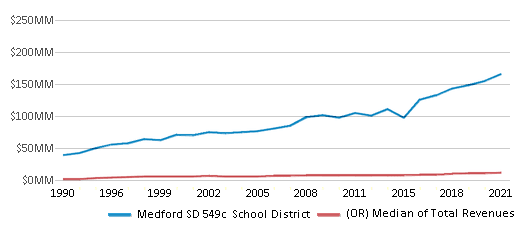
Spending
$183 MM
$10,468 MM
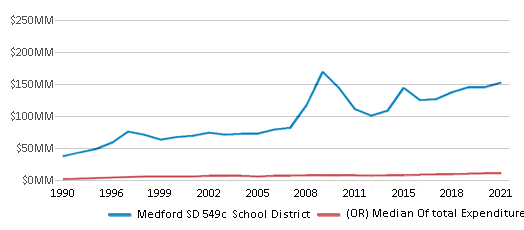
Revenue / Student
$14,541
$18,279
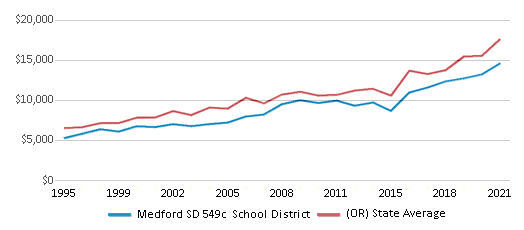
Spending / Student
$13,321
$19,325

Best Medford SD 549c School District Public Preschools (2025)
School
(Math and Reading Proficiency)
(Math and Reading Proficiency)
Location
Grades
Students
Rank: #11.
Kids Unlimited Academy
Charter School
(Math: 11% | Reading: 30%)
Rank:
Rank:
1/
Bottom 50%10
821 N Riverside Ave
Medford, OR 97501
(541) 774-3900
Medford, OR 97501
(541) 774-3900
Grades: PK-8
| 469 students
Recent Articles

Year-Round Or Traditional Schedule?
Which is more appropriate for your child? A year-round attendance schedule or traditional schedule? We look at the pros and cons.

Why You Should Encourage Your Child to Join a Sports Team
Participating in team sports has a great many benefits for children, there is no doubt. In this article you will learn what those benefits are.

White Students are Now the Minority in U.S. Public Schools
Increasing birth rates among immigrant families from Asia and Central and South America, combined with lower birth rates among white families, means that for the first time in history, public school students in the United States are majority-minority. This shift in demographics poses difficulties for schools as they work to accommodate children of varying language abilities and socio-economic backgrounds.





